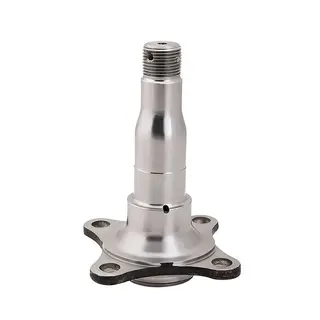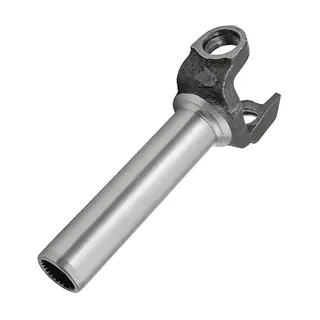In the world of machinery, the internal combustion engine is undoubtedly one of the important cornerstones of modern civilization. In this complex mechanical system, the crankshaft plays a vital role. It acts as the heart of the engine, converting the reciprocating motion of the pistons into rotational motion, driving the operation of the entire mechanical system. However, not all crankshafts are the same. The forged crankshaft, with its excellent performance, stands out among many crankshafts and has become the favorite in the field of high-performance engines.
The charm of forged crankshafts lies first in their powerful performance. Compared with traditional cast crankshafts, forged crankshafts have higher strength and reliability. This advantage comes from the particularity of the forging process. During forging, the metal material undergoes plastic deformation under high temperature and high pressure, forming a dense internal structure. This allows the forged crankshaft to withstand higher stress without fatigue fracture. In high-performance engines, this high strength and high reliability are especially important. Whether a car is speeding on the highway or a racing car is competing fiercely on the track, every part of the engine bears great pressure. The durability and fatigue resistance of the forged crankshaft can ensure the engine remains stable during long-term and high-intensity operation.
Another significant advantage of the forged crankshaft is its uniform performance. During the forging process, the metal’s fiber structure flows along the shape of the crankshaft, forming continuous fiber flow lines. This full-fiber structure makes the performance of the crankshaft consistent in all directions. In contrast, cast crankshafts may have internal defects such as air holes and sand holes due to the limitations of their manufacturing process. These defects not only affect the strength of the crankshaft but also lead to uneven performance. In the high-speed operation of an engine, this unevenness may cause vibration and noise and even lead to engine failure. The uniform performance of forged crankshafts can effectively reduce these adverse effects, improving the smoothness and comfort of engine operation.
The manufacturing process of forged crankshafts is a complex and delicate process that includes multiple key steps, each of which plays a crucial role in the quality of the final product.
The selection of materials for forged crankshafts is extremely important. Commonly used materials include carbon structural steel and alloy steel. Carbon structural steel, such as 45 steel, has high comprehensive mechanical properties, and its performance can be further improved after normalizing or tempering treatment. This material is cost-effective and suitable for engines where strength requirements are not particularly high. Alloy steels, such as 48MnV, 35CrMo, 40Cr, and 42CrMo, have excellent mechanical properties and are suitable for medium and heavy diesel engines or crankshaft processing with special requirements. These alloy steels can significantly improve the strength, fatigue strength, and wear resistance of crankshafts by adding specific alloying elements.
The forging process is the core link in the manufacture of forged crankshafts. First, select steel that meets the requirements and ensure that its chemical composition and properties are qualified. Then, remove the decarburized layer on the surface of the raw material to ensure the quality of forging. Next, heat the billet to an appropriate temperature, usually above 1200°C, using a gas furnace or medium-frequency induction heating equipment. At this temperature, the metal becomes soft and easy to forge. Using the die forging method, pressure is applied to the metal to cause plastic deformation and form the basic shape of the crankshaft. The forging process is divided into two stages: pre-forging and final forging. Each process has a certain amount of machining and forging deformation. Pre-forging mainly roughly shapes the billet, while final forging precisely processes the pre-forged billet to meet the final size and shape requirements.
After forging, the crankshaft needs to undergo heat treatment. Heat treatment is one of the key steps to improve the performance of the crankshaft. Through heat treatment, the internal stress of the crankshaft can be eliminated, and its structure and mechanical properties can be improved. The heat treatment process includes annealing, quenching, and tempering. Annealing can reduce the hardness of the crankshaft, making it easier for subsequent machining; quenching can improve the hardness and strength of the crankshaft; tempering is performed after quenching to eliminate the internal stress generated during quenching and to adjust the hardness and toughness of the crankshaft. Through a reasonable heat treatment process, the tensile strength and fatigue performance of the crankshaft can be significantly improved, allowing it to withstand higher stress without failure.
After heat treatment, the crankshaft also needs surface treatment. The surface treatment mainly includes micro-polishing and shot peening. Micro-polishing can refine the surface of the crankshaft, eliminate defects, and improve surface finish. The surface of the crankshaft after micro-polishing is flat and smooth, which can reduce friction and improve the performance of the engine. Shot peening involves spraying spherical media or “shots” onto the metal surface with sufficient force to cause plastic deformation. This process can introduce compressive stress on the surface of the crankshaft, improving its fatigue strength. After shot peening, the surface hardness and wear resistance of the crankshaft are significantly improved, and friction is reduced, extending the crankshaft’s service life.
When choosing a crankshaft, many people face the choice between forged and cast crankshafts. These two types of crankshafts have their own advantages and disadvantages and are suitable for different application scenarios.
The advantages of cast crankshafts lie in their relatively simple manufacturing process and lower production cost. The casting process mainly involves pouring molten metal into a sand mold and allowing it to cool and solidify naturally. The advantages of this process include high production efficiency, high metal utilization, and simple equipment. In addition, the development cycle of cast crankshafts is relatively short, allowing quick response to market demands. In some applications where strength requirements are not particularly high, cast crankshafts are an economical and practical choice.
However, compared with cast crankshafts, forged crankshafts have obvious performance advantages. Forged crankshafts are stronger and more durable, capable of withstanding higher stress and harsher working environments. The fatigue strength of forged crankshafts is more than 20% higher than that of cast crankshafts, meaning they can maintain stability during long-term high-intensity operation. In addition, the internal metal flow of forged crankshafts has a full-fiber structure, making the performance consistent in all directions, reducing vibration and noise. In high-performance engines, such as racing engines and heavy-duty machinery engines, forged crankshafts are the first choice. These engines need to operate under extreme conditions, and each component must have extremely high strength and reliability. The advantages of forged crankshafts enable them to meet these demanding requirements.
The excellent performance of forged crankshafts has led to their wide application in many fields.
In high-performance automotive engines, forged crankshafts are indispensable components. Whether in supercars or high-performance sedans, engine performance directly affects acceleration, top speed, and driving experience. The high strength and reliability of forged crankshafts ensure that the engine operates stably under high speeds and heavy loads. In addition, the uniform performance and low friction characteristics of forged crankshafts can improve engine efficiency, reduce fuel consumption, and lower emissions. In the racing field, forged crankshafts are regarded as essential high-performance components. Racing engines need to output enormous power in a short time while enduring extreme temperatures and pressures. The excellent performance of forged crankshafts can meet these stringent requirements and help racing cars achieve outstanding results on the track.
In addition to the automotive field, forged crankshafts are also widely used in industrial machinery. In heavy machinery, engines must withstand huge loads and long-term operation. The high strength and durability of forged crankshafts enable them to meet the needs of these machines. For example, in mining machinery, construction machinery, and agricultural machinery, engine reliability is crucial. The fatigue resistance and impact resistance of forged crankshafts ensure that the engine can operate stably in harsh environments, reducing downtime and maintenance costs.
With their excellent performance and wide range of applications, forged crankshafts occupy an important position in modern mechanical industries. They not only meet the needs of high-performance engines but also maintain stable operation in harsh working environments. With the continuous advancement of technology, the forging process of crankshafts will develop toward higher efficiency, precision, and environmental friendliness. In the future, forged crankshafts will continue to play a vital role in automobiles and industrial machinery, providing strong power support for the development of modern industry.



